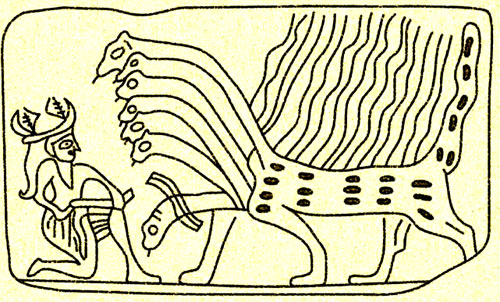|
Oct 12, 2004 To uncover the secret of the thunder-weapon in world mythology we must trace the theme back to its early expressions in ancient Mesopotamia. When the Babylonians, the world’s first astronomers, looked back to the age of the gods, they spoke incessantly of disaster. In their Akitu festival, a prototype of ancient New Year’s celebrations, the astronomer priests recounted the events of a former time, when the dragon Tiamat assaulted the world and it appeared that heaven itself would fall into chaos. (See the above image of the seven-headed dragon, Tiamat, taken from a Babylonian cylinder seal.)
The "resplendent dragon" spawned a horde of dark powers with "irresistible weapons" - "monster serpents, sharp-toothed, with fang unsparing", their bodies filled with poison for blood.
This was not a disaster on a local scale, but a universal disaster - a catastrophe so great that the gods themselves were immobilized by fear, and even Anu, the sovereign of the sky, fled the scene in terror.
Mounted on his storm-chariot and turbaned with a "fearsome halo," Marduk set his course toward the raging Tiamat. In the encounter that followed,
Cuneiform specialists confirm that the arrow of Marduk was the thunderbolt, a weapon frequently displayed throughout the ancient Near East and beyond. We have already noted that the Sumerian warrior Ninurta defeated the monster Anzu with his thunderbolt, just as the Greek Zeus subdued Typhon with the thunderbolt. But the early traditions of earthshaking battles in the heavens were not limited to any particular culture. At the temple of Ra in Heliopolis the priests ritually trod underfoot images of the great dragon Apep to represent his defeat at the hands of the supreme god.
At the temple of Edfu, a series of reliefs depict the warrior Horus and his followers vanquishing Apep or his counterpart Set, cutting to pieces the monster’s companions, the "fiends of darkness". According to W. M. Muller, the spear or harpoon of Horus was a metaphor for the thunderbolt.
The Hebrews, too, preserved an enduring memory of Yahweh’s battle against a dragon of the deep, marked by lightning on a cosmic scale.
Here the adversary was alternately named Rahab, Leviathan, Tannin, or Behemoth - dragon-like forms representing both the waters of chaos and the rebellion of the "evil land" vanquished by Yahweh in primeval times.
It is also well established that the Hebrew accounts reflect a connection to early Canaanite traditions in which the thunderbolt-wielding god Baal defeated the monster Lotan.
|
